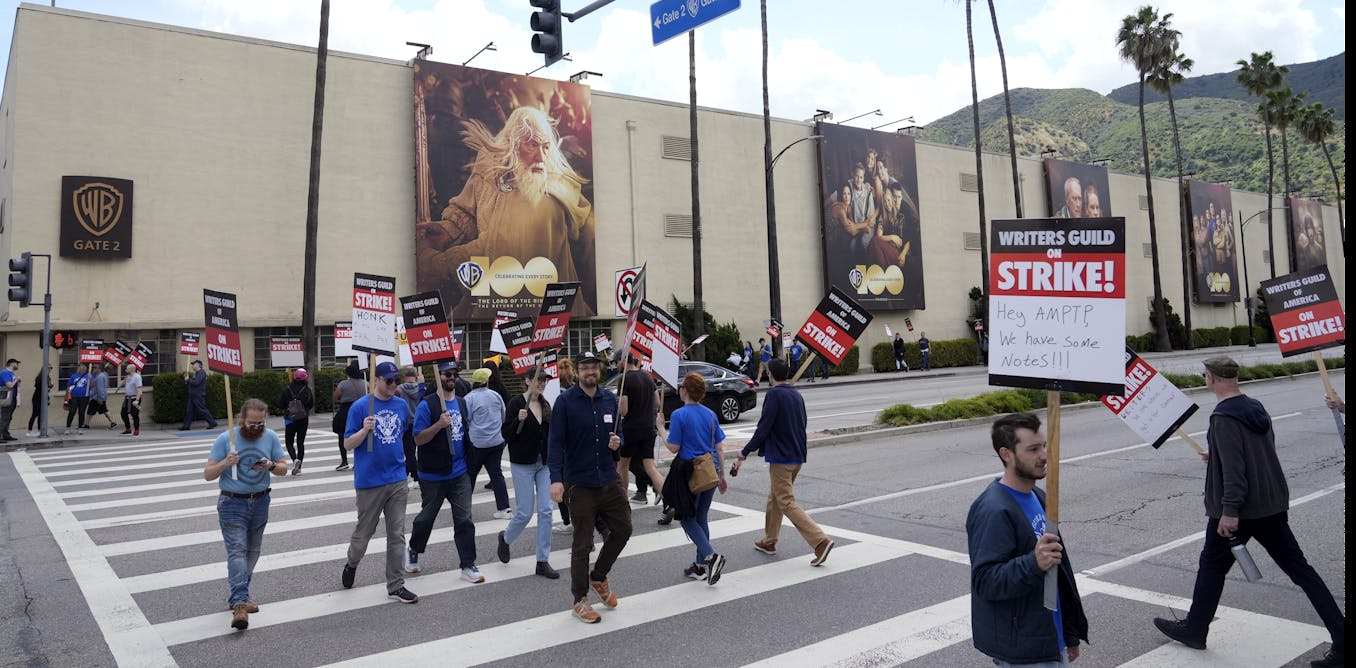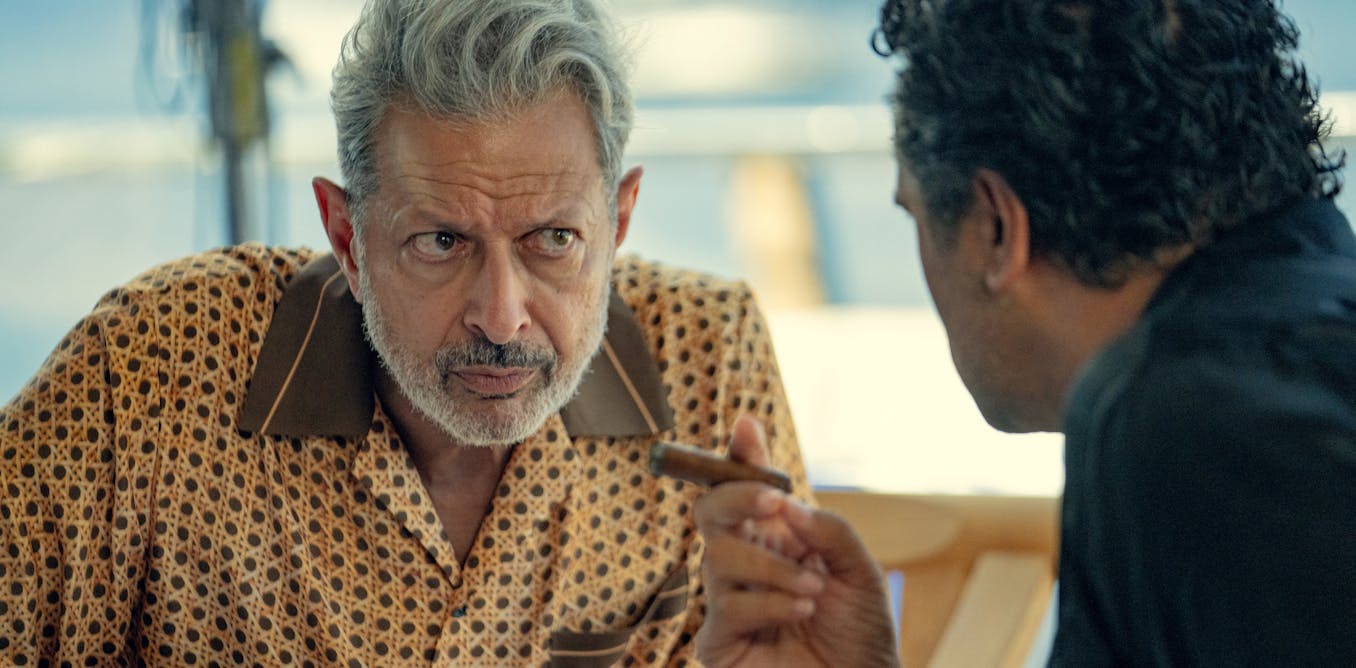Both actors and writers fear that the major studios, including Amazon/MGM, Apple, Disney/ABC/Fox, NBCUniversal, Netflix, Paramount/CBS, Sony, Warner Bros. and HBO, will use generative AI to exploit them. Generative AI is a form of artificial intelligence that learns from text and images to automatically produce new written and visual works.
So what specifically are the writers and actors afraid of? I’m a professor of cinematic arts. I conducted a brief exercise that illustrates the answer.
I typed the following sentence into ChatGPT: Create a script for a 5-minute film featuring Barbie and Ken. In seconds, a script appeared.
Next, I asked for a shot list, a breakdown of every camera shot needed for the film. Again, a response appeared almost instantly, featuring not only a “montage of fun activities,” but also a fancy flashback sequence. The closing line suggested a wide shot showing “Barbie and Ken walking away from the beach together, hand in hand.”
Next, on a text-to-video platform, I typed these words into a box labeled “Prompt”: “Cinematic movie shot of Margot Robbie as Barbie walking near the beach, early morning light, pink sun rays illuminating the screen, tall green grass, photographic detail, film grain.”
About a minute later, a 3-second video appeared. It showed a svelte blond woman walking on the beach. Is it Margot Robbie? Is it Barbie? It’s hard to say. I decided to add my own face in place of Robbie’s just for fun, and in seconds, I’ve made the swap.
I now have a moving image clip on my desktop that I can add to the script and shot list, and I’m well on my way to crafting a short film starring someone sort of like Margot Robbie as Barbie.
The fear
None of this material is particularly good. The script lacks tension and poetic grace. The shot list is uninspired. And the video is just plain weird-looking.
However, the ability for anyone – amateurs and professionals alike – to create a screenplay and conjure the likeness of an existing actor means that the skills once specific to writers and the likeness that an actor once could uniquely call his or her own are now readily available – with questionable quality, to be sure – to anyone with access to these free online tools.
Given the rate of technological change, the quality of all this material created through generative AI is destined to improve visually, not only for people like me and social media creatives globally, but possibly for the studios, which are likely to have access to much more powerful computers. Further, these separate steps – preproduction, screenwriting, production, postproduction – could be absorbed into a streamlined prompting system that bears little resemblance to today’s art and craft of moviemaking.
Writers fear that, at best, they will be hired to edit screenplays drafted by AI. They fear that their creative work will be swallowed whole into databases as the fodder for writing tools to sample. And they fear that their specific expertise will be pushed aside in favor of “prompt engineers,” or those skilled at working with AI tools.
And actors fret that they will be forced to sell their likeness once, only to see it used over and over by studios. They fear that deepfake technologies will become the norm, and real, live actors won’t be needed at all. And they worry that not only their bodies but their voices will be taken, synthesized and reused without continued compensation. And all of this is on top of dwindling incomes for the vast majority of actors.
On the road to the AI future
Are their fears justified? Sort of. In June 2023, Marvel showcased titles – opening sequences with episode names – for the series “Secret Invasion” on Disney+ that were created in part with AI tools. The use of AI by a major studio sparked controversy due in part to the timing and fears about AI displacing people from their jobs. Further, series director and executive producer Ali Selim’s tone-deaf description of the use of AI only added to the sense that there is little concern at all about those fears.
Then on July 26, software developer Nicholas Neubert posted a 48-second trailer for a sci-fi film made with images made by AI image generator Midjourney and motion created by Runway’s image-to-motion generator, Gen-2. It looks terrific. No screenwriter was hired. No actors were used.
In addition, earlier this month, a company called Fable released Showrunner AI, which is designed to allow users to submit images and voices, along with a brief prompt. The tool responds by creating entire episodes that include the user.
The creators have been using South Park as their sample, and they have presented plausible new episodes of the show that integrate viewers as characters in the story. The idea is to create a new form of audience engagement. However, for both writers and actors, Showrunner AI must be chilling indeed.
Finally, Volkswagen recently produced a commercial that features an AI reincarnation of Brazilian musician Elis Regina, who died in 1982. Directed by Dulcidio Caldeira, it shows the musician as she appears to sing a duet with her daughter. For some, the song was a beautiful revelation, crafting a poignant mother-daughter reunion.
However, for others, the AI regeneration of someone who has died prompts worries about how one’s likeness might be used after death. What if you are morally opposed to a particular film project, TV show or commercial? How will actors – and others – be able to retain control?
Keeping actors and writers in the credits
Writers’ and actors’ fears could be assuaged if the entertainment industry developed a convincing and inclusive vision that acknowledges advances in AI, but that collaborates with writers and actors, not to mention cinematographers, directors, art designers and others, as partners.
At the moment, developers are rapidly building and improving AI tools. Production companies are likely to use them to dramatically cut costs, which will contribute to a massive shift toward a gig-oriented economy. If the dismissive attitude toward writers and actors held by many of the major studios continues, not only will there be little consideration of the needs of writers and actors, but technology development will lead the conversation.
However, what if the tools were designed with the participation of informed actors and writers? What kind of tool would an actor create? What would a writer create? What sorts of conditions regarding intellectual property, copyright and creativity would developers consider? And what sort of inclusive, forward-looking, creative cinematic ecosystem might evolve? Answering these questions could give actors and writers the assurances they seek and help the industry adapt in the age of AI.




















